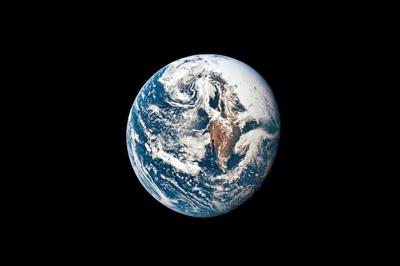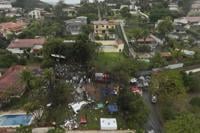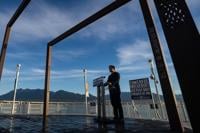Memes, videos and arguments supporting the flat Earth conspiracy theory have a long history of being passed around on social media, despite overwhelming scientific evidence the Earth is a sphere. An image shared last month on Twitter includes a picture allegedly taken by NASA depicting the Earth’s surface as curved, juxtaposed with another image purportedly taken by an amateur weather balloon that appears to show its surface being flat, with text claiming that both were taken at the same altitude of 100,000 feet (about 30 kilometres). This is misleading. The first picture was not taken by NASA and the second picture appears to be from a panoramic view of the Earth that's been distorted to make the horizon appear flat.
There are several different variations of the flat Earth theory: one proposes that the Earth is a flat, immovable disc, with the North Pole at its centre and an ice wall beyond Antarctica, another claims the flat Earth is covered by a dome, like a snow globe, that prevents things from falling off the edge. Evidence of a spherical Earth, such as pictures from the moon landing, are brushed off as fakes, fuelled by mistrust of government agencies.
The misleading image was shared on Twitter by ��, with one remarking, "Strange how only NASA’s cameras pick up the Earth’s curvature…"
Rating: Misleading
The text paired with the first image claims it was taken by NASA, but the private stratospheric exploration company . The photo was released in June 2014, and has been used in marketing material for the company's commercial venture to bring passengers to an altitude of more than 32 kilometres using a balloon.
The second picture appears to be a lower-quality version of a 360-degree taken in 2015 above the Caucasus Mountains in Russia for panoramic photography site AirPano. The interactive, 360-degree view shows an Earth that is clearly curved, but the website also includes a in which the horizon appears more flat.
It's not clear what camera equipment was used to capture both images, but both used high-altitude balloons capable of reaching an altitude of at least 30 kilometres in the process.
Lens distortion
There are many images and available online from amateur stratospheric explorers. In many of the , the cameras use a wide-angle lens, which creates a wide field of view but distorts the image around the edges. This is known as .
In these videos, the camera swings up and down, buffeted by wind, creating moments when the Earth's horizon appears flat, convex and concave, depending on its position relative to the optical axis – or centre line – of the camera lens.
According to published in April 2008 by , a researcher in the field of optics in nature, "To accurately assess curvature from a photograph, the horizon must be placed precisely in the center of the image."
In the two videos cited above, pausing the video at a moment when the horizon crosses the centre of the image shows a horizon that is curved, not flat.
A website dedicated to offers a similar explanation, and includes used in the claim on Twitter.
Lynch's paper, which explains how to visually discern the curvature of the Earth, suggests that a person would need to be at an elevation of slightly less than 35,000 feet (10,668 metres) to see the curvature of the planet, and that the curvature is measurable as low as 20,000 feet (6,096 metres) in photographs. Both videos cited above were recorded at well above those thresholds.
Sources
()
The claim can be found on Twitter () and archived
() used at the top of the claim was taken by stratospheric exploration company ()
The image from the bottom comes from a 360-degree panorama from (), and appears as a still image ()
Video examples of high-altitude balloon flights can be found () and ()
()
()
()
Flatearth.ws – (), ()
About Canadian Press fact checks
You can find out more about ������ϲʹ������� here. To reach our fact-checking team with any tips, corrections or comments, please email us at cpfactcheck@thecanadianpress.com.





































